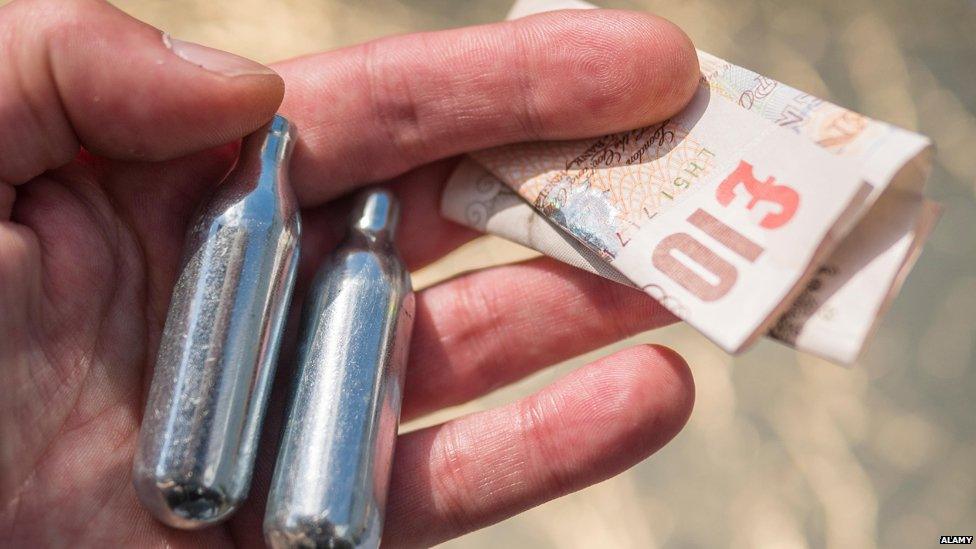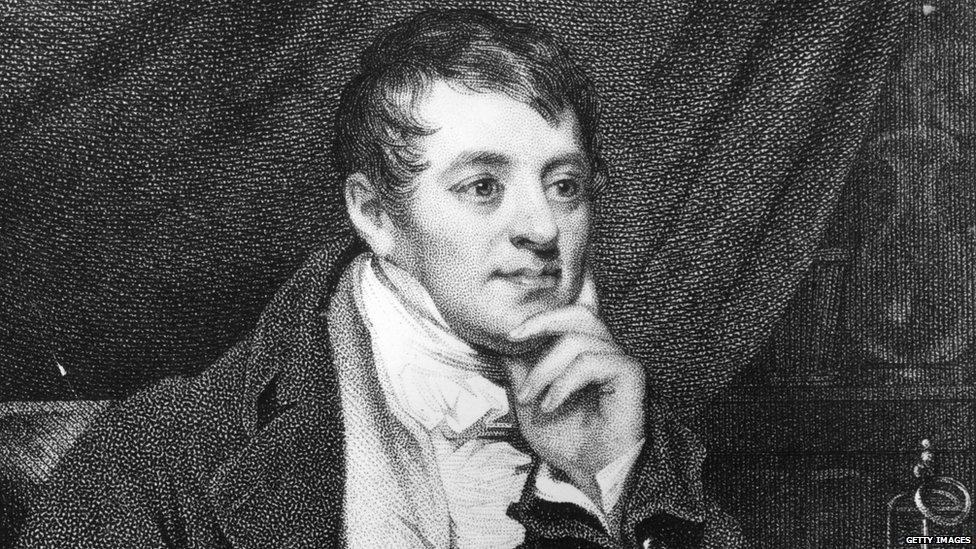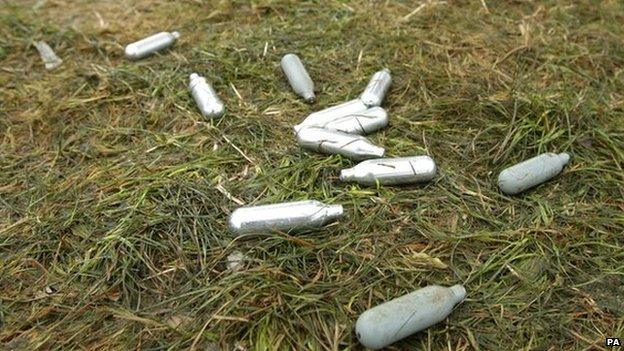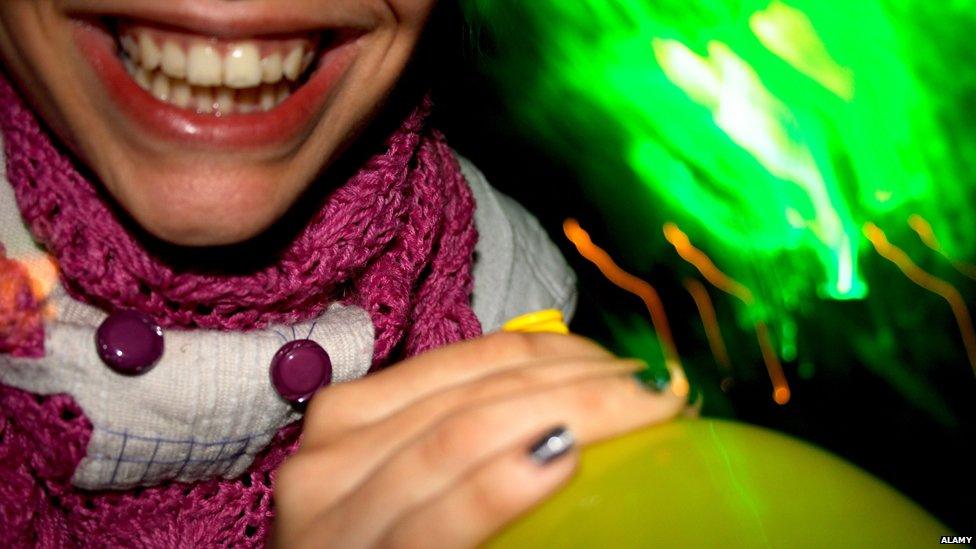How dangerous is laughing gas?
- Published

The UK government is moving to ban the sale of nitrous oxide to clubbers and partygoers because of its dangers, but some users are protesting that the move is unfair. Exactly how dangerous is the gas?
Empty silver canisters of nitrous oxide, or laughing gas, have become a common sight outside clubs across the UK. Last July, more than 1,200 were reported to have been confiscated on just one Saturday night in London's Shoreditch.
The anaesthetic gas is still used for pain relief during dentistry and childbirth but outside of that legitimate arena there has been a legal grey area for years. It's already illegal to sell to under-18s if there is a risk they will inhale it. But it remains easy for adults to buy.
Mainstream online vendors advertise the product, although usually indicating that it is to be used for the production of whipped cream. The product reviews usually suggest otherwise. One reads: "Quality product, I ordered on a Friday and chargers were meant to come on Tuesday but arrived on the next day, good laugh with mates at a festival… er, I mean in the kitchen whipping cream."
Now the UK government plans to include nitrous oxide in a bill which will make it illegal to sell "psychoactive substances". Possession - with no intent to supply - and use will remain legal.
"Young people who take these substances are taking exceptional risks with their health and those who profit from their sale have a complete disregard for the potential consequences," said crime and policing minister Mike Penning.
But some argue that the ban is unfair. On Saturday, protesters from the Psychedelic Society pressure group will inhale laughing gas outside Parliament.
"It's not the business of government to tell people what they can and can't use," says director Stephen Reid. "Nitrous oxide has been used for literally hundreds of years in this country without any problems."
It was discovered in 1772 by British scientist Joseph Priestley and within 30 years the chemist Humphry Davy was using it recreationally.
Davy began inviting his friends round to inhale the gas from oiled silk bags and in doing so started a craze. "The nitrous oxyd [sic], or laughing gas was inhaled by a gentleman who after laughing sprung up in the air to the astonishing height of six feet from the ground," wrote a correspondent in the Times in 1819, describing a popular stage show.

Sir Humphry Davy, an early recreational user
"You kind of feel that you're in a trance," says Reid. "Some people get a sensation that they're falling or being lifted up into the sky perhaps. When you start coming out of this trance-like state you often get these giggles."
Recreational use of nitrous oxide has not always been common. The controversial 1995 movie Kids shows one of the characters using it, but the popularity of the gas has increased dramatically in the past five years, says Stephen Ream, a director of drug charity Re-Solv.

Laughing gas and the philosopher
"[The 19th Century US philosopher] William James describes a man who got the experience from laughing-gas; whenever he was under its influence, he knew the secret of the universe, but when he came to, he had forgotten it. At last, with immense effort, he wrote down the secret before the vision had faded. When completely recovered, he rushed to see what he had written. It was: A smell of petroleum prevails throughout."
From A History of Western Philosophy, Bertrand Russell (1945)

Laughing gas is now the fourth most used drug in the UK, according to the Global Drug Survey 2015, external. In the past year, only people in the Netherlands used it more.
In 2013-14, some 470,000 people took nitrous oxide, according to the Home Office, external. It's especially popular with young people, with 7.6% of 16 to 24-year-olds taking it that same year. This was a greater proportion than took cocaine (4.2%) and ecstasy (3.9%).
There have, however, been 17 fatalities related to the use of laughing gas in the UK between 2006 and 2012, according to research.
The Advisory Council on the Misuse of Drugs (ACMD) says that there was one death in 2011 and five in 2010, external. The US records about 15 deaths a year.
In 2007, a 23-year-old man was found dead at his home in Birmingham next to a large cylinder of nitrous oxide. A plastic bag was also found nearby, it was reported. The pathologist concluded that he had died from asphyxia due to inhaling the gas.
Others have also taken severe risks by using medical tanks and masks. But the majority of people who consume the gas, according to research, do so using balloons.

Discarded laughing gas canisters - a familiar sight at music festivals
Most of the deaths in the UK have been asphyxiations involving plastic bags, says Dr John Ramsey, a toxicologist who was part of the team that helped compile the death data, external, using coroner's reports at St George's, University of London.
As well as the danger of asphyxiation, when the gas comes out of a canister it can be so cold it can burn. A cold shock at the back of the throat can affect the vagus nerve, causing the heart rate to suddenly slow.
Researchers say that the number of people who die from inhaling nitrous oxide is actually low when compared with the number of people taking the drug every year.
"There's been something like 40-odd deaths in the last 40 years. They're really rare," says Dr Adam Winstock, consultant psychiatrist and founder of the Global Drug Survey.
Death rates can be difficult to compare but in 2011 nitrous oxide was linked to one death - this was fewer than heroin and morphine (2,652), cocaine (112), ecstasy (13) and cannabis (seven)., external

The number of laughing gas deaths is fewer than those killed each year by helium, says David Nutt, professor of neuropsychopharmacology at Imperial College, London and former UK government drugs adviser. He argues that laughing gas is actually "exceptionally safe" considering the numbers who use it.
"I mean you can kill yourself obviously. If you breathe nothing but nitrous for 10 minutes you will die, but I don't think there's any evidence that nitrous kills people if you use it recreationally."
But to some critics, the dangers are clear. Breathing in high concentrations of laughing gas can quickly reduce the blood's level of oxygen.
On a night out, in an uncontrolled environment, there is a risk that people can start feeling sleepy as they inhale the gas and pass out, says Dr Anna-Maria Rollin from the Royal College of Anaesthetists. "The risk of brain damage just isn't worth it as far as I can tell."
In March, doctors from the Royal Alexandra Children's Hospital in Brighton warned against using laughing gas after a teenager arrived in their emergency unit with breathing difficulties. She had inhaled a considerable quantity at a festival and air had leaked into the space between her lung and chest wall which can cause the lung to collapse.
Heavy use can also deplete the body's stores of vitamin B12, causing anaemia and nerve damage. The Global Drugs Survey found that about 4% of users had symptoms such as numbness, tingling and shooting pains in the limbs.
People often use nitrous oxide in conjunction with cannabis or alcohol, explains Shirley Cramer, chief executive of the Royal Society for Public Health. That too is a concern, she says, as it increases the risks involved.

Nitrous oxide
Effects: Feelings of euphoria, relaxation and calmness, dizziness, difficulty in thinking straight and fits of giggles/laughter, sound distortions or even hallucinations
Risks: If gas is consumed in an enclosed space or if a plastic bag is used, it may cause lack of oxygen; heavy regular use can lead to severe vitamin B12 deficiency and anaemia; it may also depress formation of white blood cells
If someone collapses after using nitrous oxide, call an ambulance immediately, turn them on to their side to avoid choking and stay with them until the ambulance arrives
Source: Frank, external

But in general, most users are not consuming laughing gas heavily and at that level it is "a remarkably safe drug", says Winstock, "unless you are drunk or high on other drugs and you happen to do it in the middle of the road and you fall over".
"But it's important to say that it is not harmless," says Dr Owen Bowden-Jones, consultant psychiatrist and founder of the Club Drug clinic. "Some of those risks are to do with the way it's taken and some of it, as with most drugs, is with how frequently you use it."
Perhaps the greatest danger is that more young people end up inhaling gases that they think are nitrous oxide but are in fact a dangerous substitute.
When 17-year-old Joseph Benett died in 2012, it was reported as a death from laughing gas. He had in fact consumed a cocktail of gases including butane and pentane from a can brought back from Israel.
"What we worry about is that people start to think that inhaling gas for a laugh is an OK thing to do," says Ream. It's certainly not right or normal to inhale a gas for intoxication, he says.
Subscribe to the BBC News Magazine's email newsletter, external to get articles sent to your inbox.